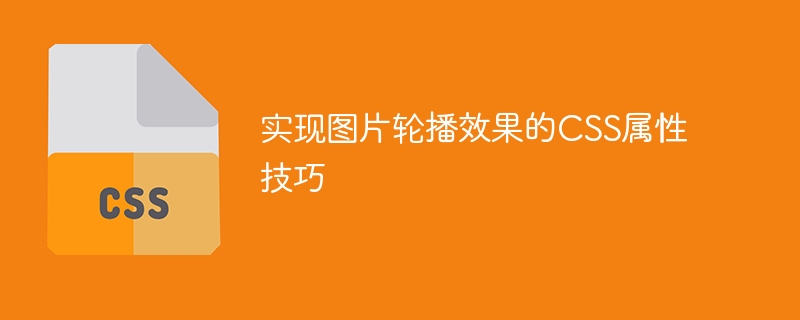

CSS attribute skills to achieve image carousel effect, specific code examples are required
In modern web design, image carousel effect has become one of the most common elements . With image carousel effects, web pages can be more dynamic and attractive. This article will introduce several CSS property techniques to achieve image carousel effects, and give specific code examples.
The animation attribute is a property in CSS3 that can be used to create animation effects. By setting animation attributes and @keyframes rules, we can achieve the image carousel effect. The following is a code example that uses the animation attribute to implement image carousel:
HTML code:
<div class="slideshow"> <img src="image1.jpg" alt="Image 1"> <img src="image2.jpg" alt="Image 2"> <img src="image3.jpg" alt="Image 3"> </div>
CSS code:
.slideshow {
width: 500px;
height: 300px;
position: relative;
overflow: hidden;
}
.slideshow img {
width: 100%;
height: 100%;
position: absolute;
top: 0;
left: 0;
opacity: 0;
animation: fade 5s infinite;
}
@keyframes fade {
0% {
opacity: 0;
}
20% {
opacity: 1;
}
33% {
opacity: 1;
}
53% {
opacity: 0;
}
100% {
opacity: 0;
}
}In the above code, we create a 500px Container with width and height of 300px, and set relative positioning and overflow:hidden attributes to the container. Then, we set absolute positioning for each image and set the opacity attribute to 0 to hide the image. Finally, we use the animation attribute and the @keyframes rule to set the transparency animation of the image to achieve the image carousel effect.
The transform attribute is a property in CSS3 that can be used to transform elements such as displacement, rotation, and scaling. By setting the transform attribute, we can achieve the panning carousel effect of images. The following is a code example that uses the transform attribute to implement image panning carousel:
HTML code:
<div class="slideshow"> <img src="image1.jpg" alt="Image 1"> <img src="image2.jpg" alt="Image 2"> <img src="image3.jpg" alt="Image 3"> </div>
CSS code:
.slideshow {
width: 500px;
height: 300px;
position: relative;
overflow: hidden;
}
.slideshow img {
width: 100%;
height: 100%;
position: absolute;
top: 0;
left: -100%;
transition: transform 1s;
}
.slideshow img:first-child {
left: 0;
}
.slideshow img:hover {
transform: translateX(100%);
}In the above code, we use absolute positioning to Each image is positioned at the far left of the container, and the transition attribute is used to set the translation animation of the image. Then, we use the :first-child pseudo-class selector to display the first image inside the container. Finally, we use the :hover pseudo-class selector and the transform attribute to achieve the image translation effect when the mouse is hovering.
The above are two techniques and code examples for using CSS properties to achieve image carousel effects. By using the animation attribute and transform attribute, we can easily achieve various dynamic image carousel effects, adding more vitality and appeal to the web page.
The above is the detailed content of CSS attribute techniques to achieve image carousel effect. For more information, please follow other related articles on the PHP Chinese website!